Abstract
The predominant role of Eptesicus serotinus in the epizootic of bat rabies in Europe was further outlined by the first isolation of the rabies virus from this species in France. The distribution of the virus was studied in naturally infected E. serotinus bats at the time of death and suggested that the papillae of the tongue and the respiratory mucosa may play a role in virus production and excretion. The analysis of 501 French rabies virus isolates from various animal species by antinucleocapsid monoclonal antibodies indicated that transmission of the disease from bats to terrestrial animals is unlikely. The antigenic profile of two isolates from French bats corresponded to that of European bat lyssavirus type 1 (EBL1). Comparisons of 12 different isolates from bats with antinucleocapsid and antiglycoprotein monoclonal antibodies and by direct sequencing of the polymerase chain reaction amplification product of the N gene indicated that EBL1, EBL2, Duvenhage virus (serotype 4 of lyssavirus), and the European fox rabies virus (serotype 1) are phylogenetically distant. They formed four tight genetic clusters named genotypes. EBL1 was shown to be antigenically and genetically more closely related to Duvenhage virus than to EBL2. We propose that EBL1 and EBL2 constitute two distinct genotypes which further serologic characterization will probably classify as new serotypes. We also report a simple method for the rapid characterization of EBL based on the digestion of the polymerase chain reaction product of the N gene by three restriction endonucleases.
Full text
PDF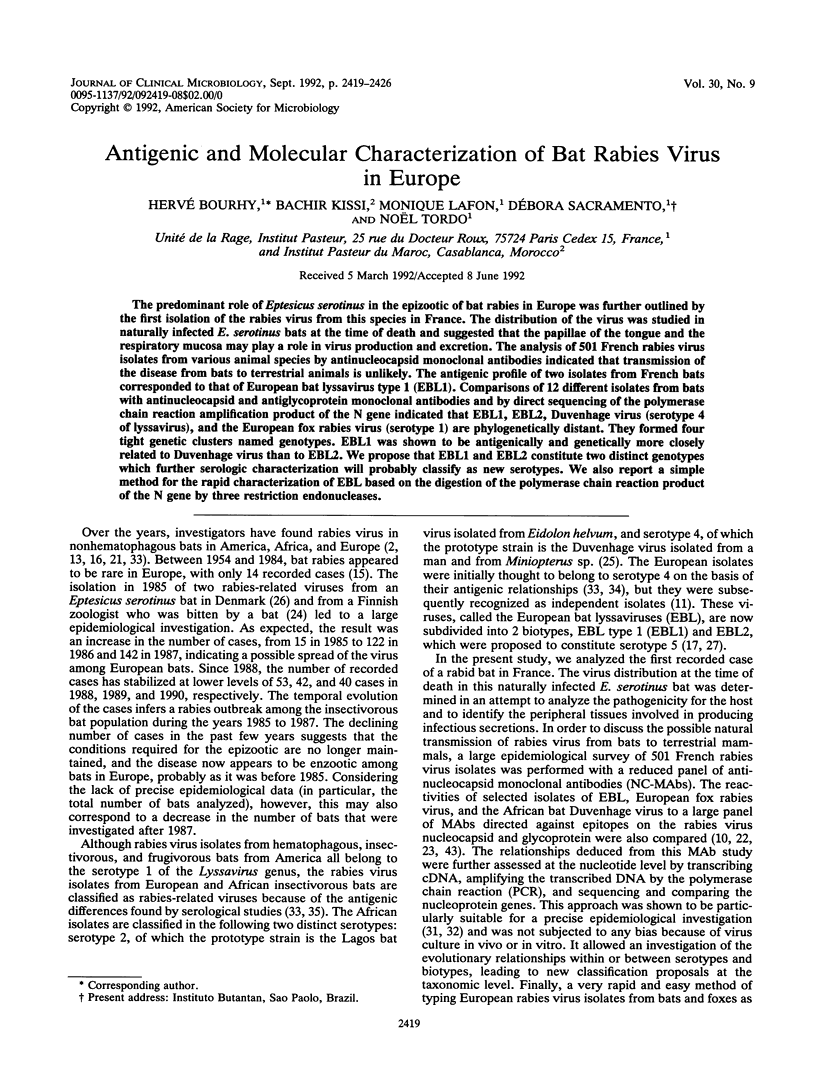
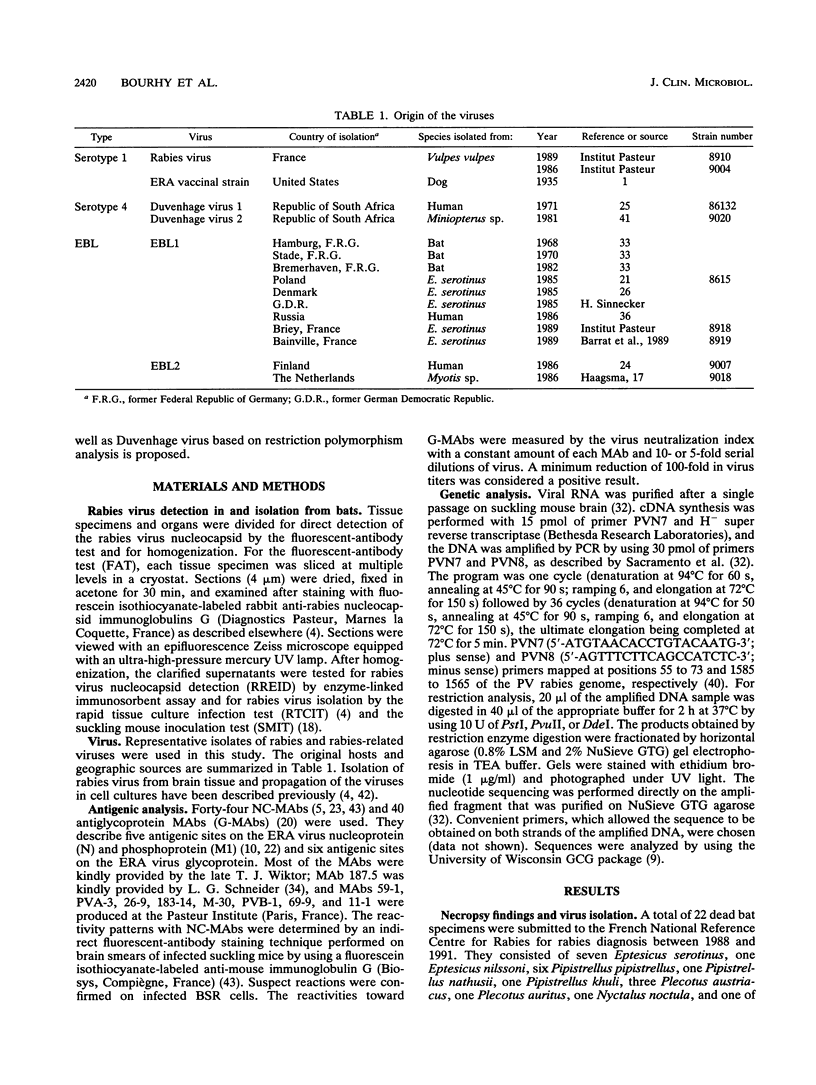
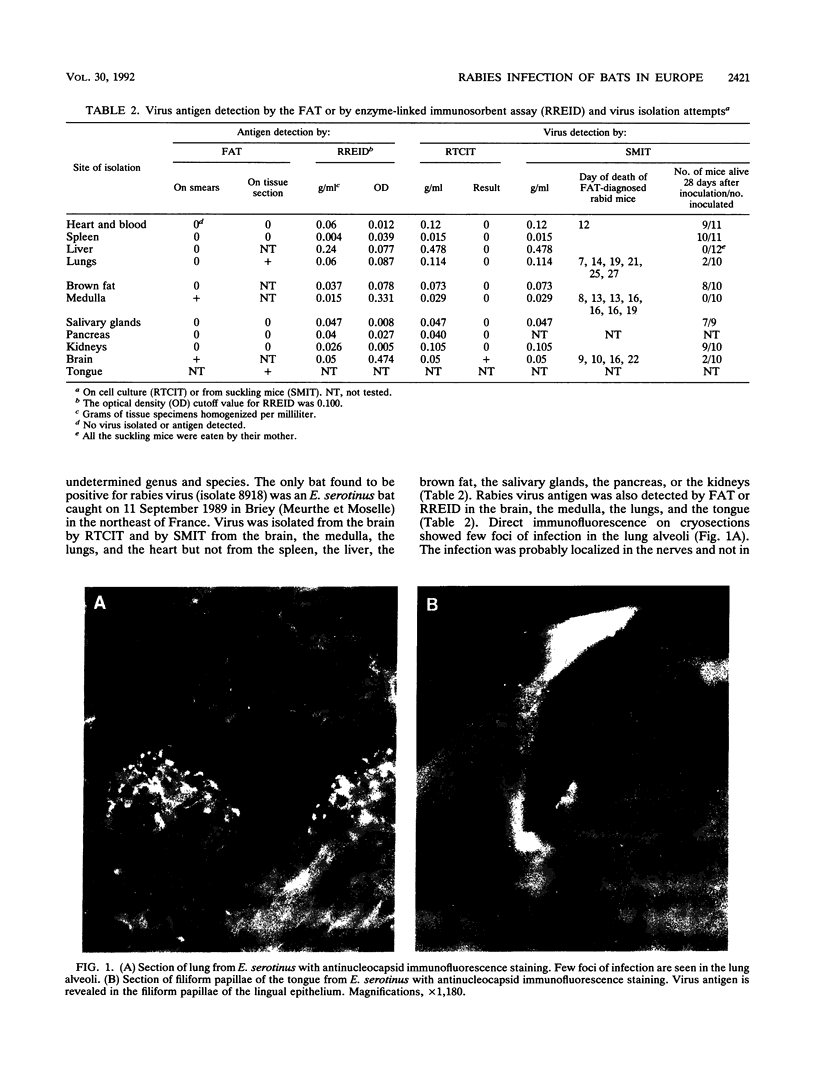
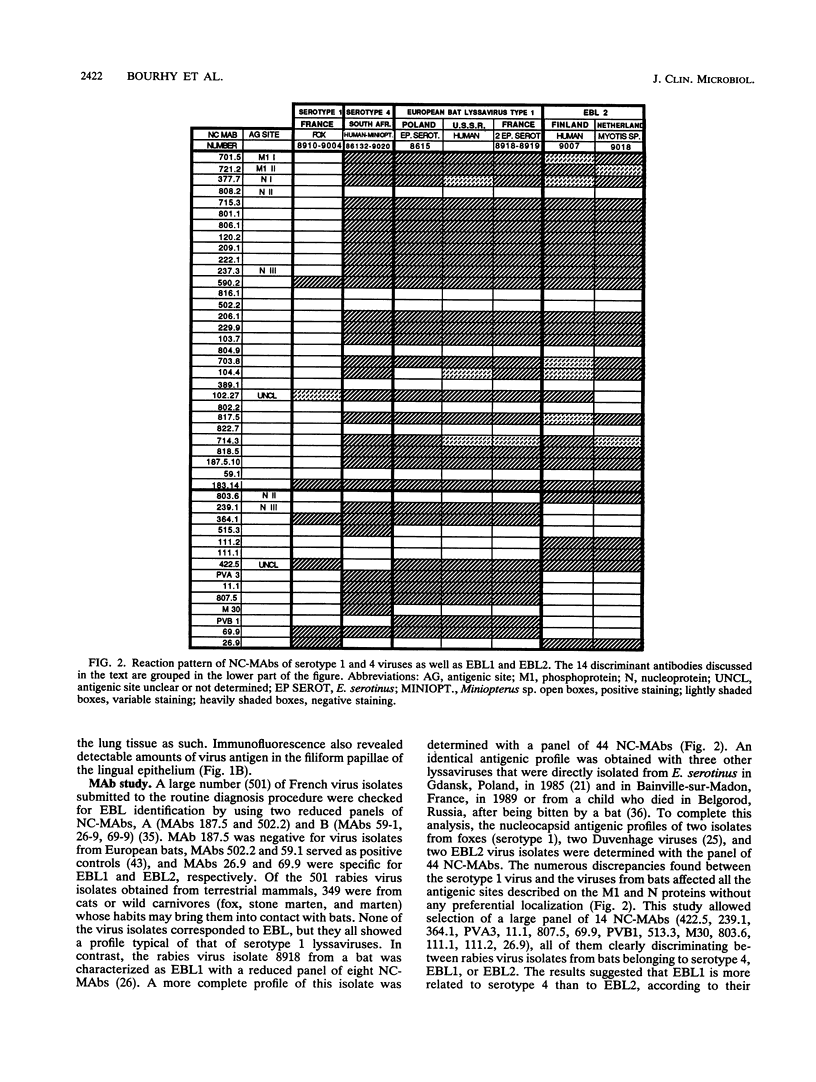

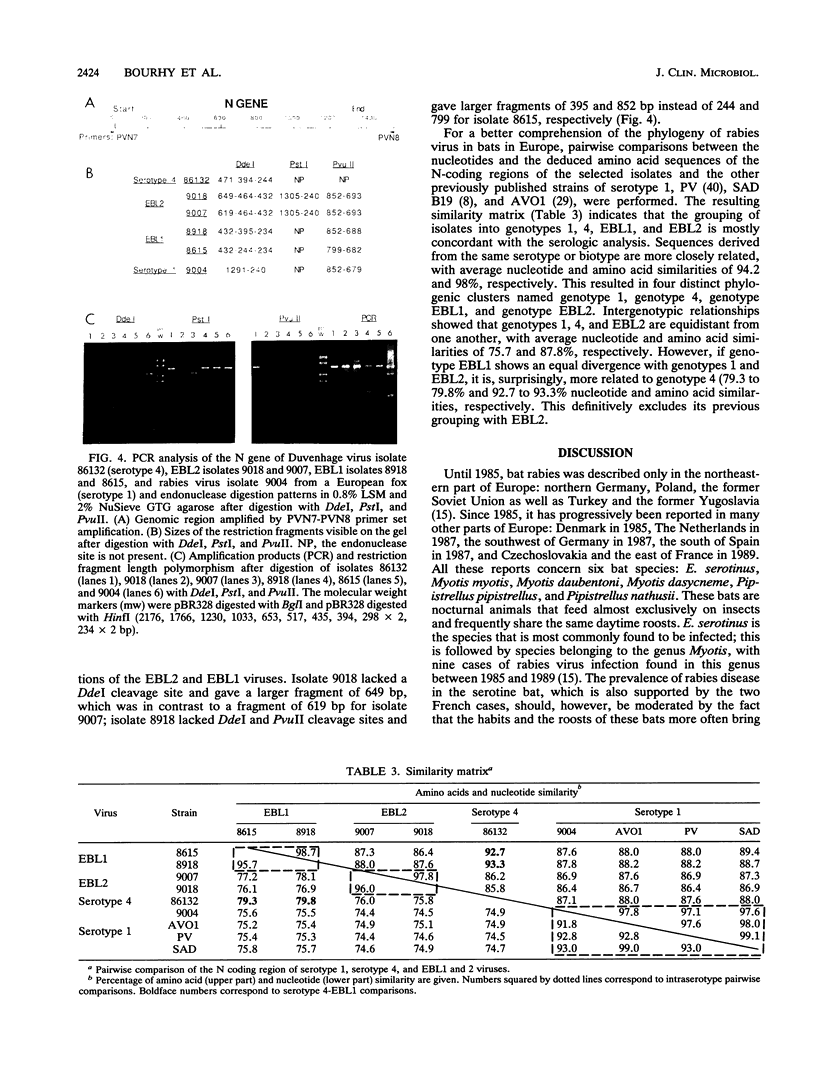
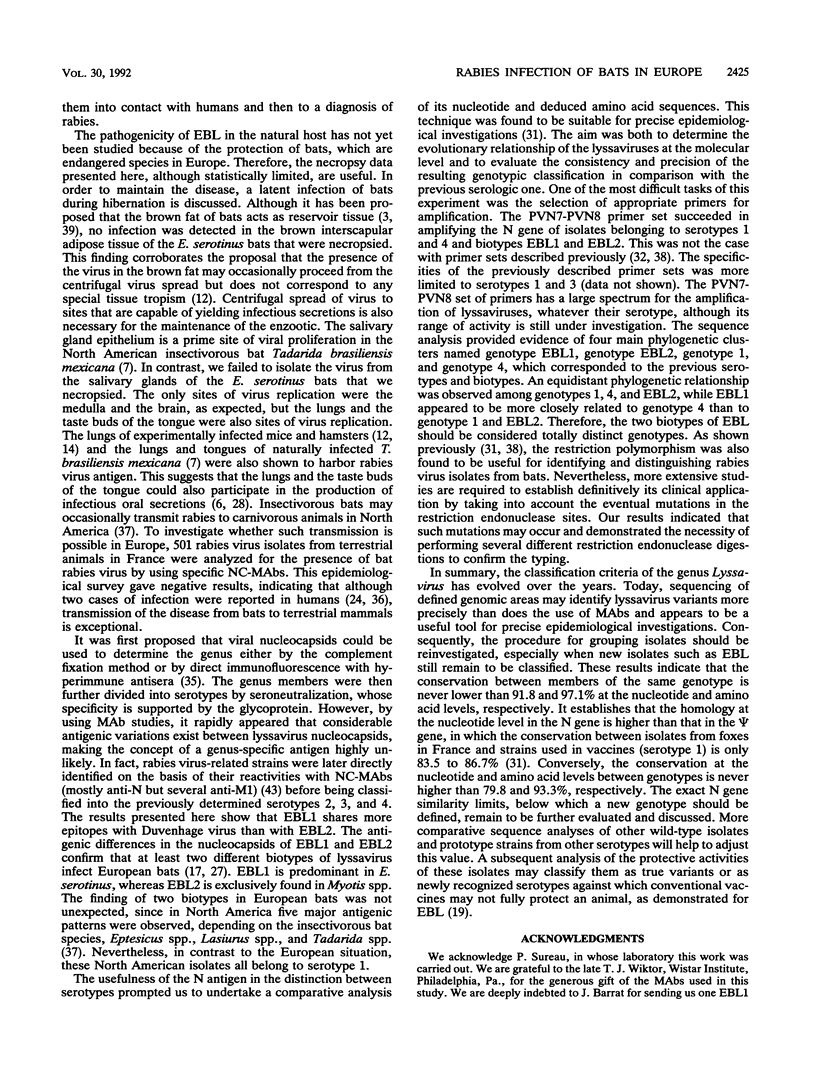
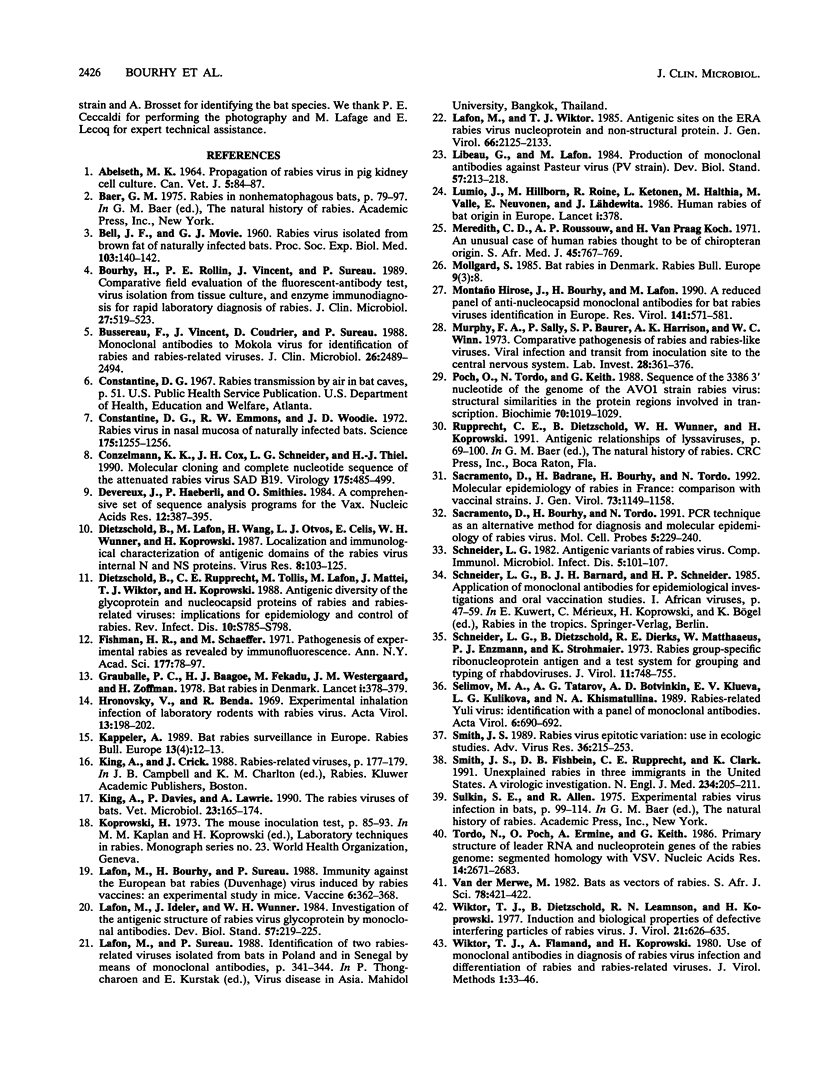
Images in this article
Selected References
These references are in PubMed. This may not be the complete list of references from this article.
- Abelseth M. K. Propagation of Rabies Virus in Pig Kidney Cell Culture. Can Vet J. 1964 Apr;5(4):84–87. [PMC free article] [PubMed] [Google Scholar]
- BELL J. F., MOORE G. J. Rabies virus isolated from brown fat of naturally infected bats. Proc Soc Exp Biol Med. 1960 Jan;103:140–142. doi: 10.3181/00379727-103-25438. [DOI] [PubMed] [Google Scholar]
- Bourhy H., Rollin P. E., Vincent J., Sureau P. Comparative field evaluation of the fluorescent-antibody test, virus isolation from tissue culture, and enzyme immunodiagnosis for rapid laboratory diagnosis of rabies. J Clin Microbiol. 1989 Mar;27(3):519–523. doi: 10.1128/jcm.27.3.519-523.1989. [DOI] [PMC free article] [PubMed] [Google Scholar]
- Brown G. W., Davidson S. Social class, psychiatric disorder of mother, and accidents to children. Lancet. 1978 Feb 18;1(8060):378–381. doi: 10.1016/s0140-6736(78)91097-8. [DOI] [PubMed] [Google Scholar]
- Bussereau F., Vincent J., Coudrier D., Sureau P. Monoclonal antibodies to Mokola virus for identification of rabies and rabies-related viruses. J Clin Microbiol. 1988 Dec;26(12):2489–2494. doi: 10.1128/jcm.26.12.2489-2494.1988. [DOI] [PMC free article] [PubMed] [Google Scholar]
- Constantine D. G., Emmons R. W., Woodie J. D. Rabies virus in nasal mucosa of naturally infected bats. Science. 1972 Mar 17;175(4027):1255–1256. doi: 10.1126/science.175.4027.1255. [DOI] [PubMed] [Google Scholar]
- Conzelmann K. K., Cox J. H., Schneider L. G., Thiel H. J. Molecular cloning and complete nucleotide sequence of the attenuated rabies virus SAD B19. Virology. 1990 Apr;175(2):485–499. doi: 10.1016/0042-6822(90)90433-r. [DOI] [PubMed] [Google Scholar]
- Devereux J., Haeberli P., Smithies O. A comprehensive set of sequence analysis programs for the VAX. Nucleic Acids Res. 1984 Jan 11;12(1 Pt 1):387–395. doi: 10.1093/nar/12.1part1.387. [DOI] [PMC free article] [PubMed] [Google Scholar]
- Dietzschold B., Lafon M., Wang H., Otvos L., Jr, Celis E., Wunner W. H., Koprowski H. Localization and immunological characterization of antigenic domains of the rabies virus internal N and NS proteins. Virus Res. 1987 Aug;8(2):103–125. doi: 10.1016/0168-1702(87)90023-2. [DOI] [PubMed] [Google Scholar]
- Dietzschold B., Rupprecht C. E., Tollis M., Lafon M., Mattei J., Wiktor T. J., Koprowski H. Antigenic diversity of the glycoprotein and nucleocapsid proteins of rabies and rabies-related viruses: implications for epidemiology and control of rabies. Rev Infect Dis. 1988 Nov-Dec;10 (Suppl 4):S785–S798. doi: 10.1093/clinids/10.supplement_4.s785. [DOI] [PubMed] [Google Scholar]
- Fischman H. R., Schaeffer M. Pathogeneis of experimental rabies as revealed by immunofluorescence. Ann N Y Acad Sci. 1971 Jun 21;177:78–97. doi: 10.1111/j.1749-6632.1971.tb35035.x. [DOI] [PubMed] [Google Scholar]
- Hirose J. A., Bourhy H., Lafon M. A reduced panel of anti-nucleocapsid monoclonal antibodies for bat rabies virus identification in Europe. Res Virol. 1990 Sep-Oct;141(5):571–581. doi: 10.1016/0923-2516(90)90088-z. [DOI] [PubMed] [Google Scholar]
- Hronovský V., Benda R. Development of inhalation rabies infection in suckling guinea pigs. Acta Virol. 1969 May;13(3):198–202. [PubMed] [Google Scholar]
- King A., Davies P., Lawrie A. The rabies viruses of bats. Vet Microbiol. 1990 Jun;23(1-4):165–174. doi: 10.1016/0378-1135(90)90146-m. [DOI] [PubMed] [Google Scholar]
- Koprowski H. Laboratory techniques in rabies: the mouse inoculation test. Monogr Ser World Health Organ. 1973;(23):85–93. [PubMed] [Google Scholar]
- Lafon M., Bourhy H., Sureau P. Immunity against the European bat rabies (Duvenhage) virus induced by rabies vaccines: an experimental study in mice. Vaccine. 1988 Aug;6(4):362–368. doi: 10.1016/0264-410x(88)90184-3. [DOI] [PubMed] [Google Scholar]
- Lafon M., Ideler J., Wunner W. H. Investigation of the antigenic structure of rabies virus glycoprotein by monoclonal antibodies. Dev Biol Stand. 1984;57:219–225. [PubMed] [Google Scholar]
- Lafon M., Wiktor T. J. Antigenic sites on the ERA rabies virus nucleoprotein and non-structural protein. J Gen Virol. 1985 Oct;66(Pt 10):2125–2133. doi: 10.1099/0022-1317-66-10-2125. [DOI] [PubMed] [Google Scholar]
- Libeau G., Lafon M. Production of monoclonal antibodies against the Pasteur (P.V.) strain of rabies virus: problems and results. Dev Biol Stand. 1984;57:213–218. [PubMed] [Google Scholar]
- Lumio J., Hillbom M., Roine R., Ketonen L., Haltia M., Valle M., Neuvonen E., Lähdevirta J. Human rabies of bat origin in Europe. Lancet. 1986 Feb 15;1(8477):378–378. doi: 10.1016/s0140-6736(86)92336-6. [DOI] [PubMed] [Google Scholar]
- Meredith C. D., Prossouw A. P., Koch H. van P. An unusual case of human rabies thought to be of chiropteran origin. S Afr Med J. 1971 Jul 17;45(28):767–769. [PubMed] [Google Scholar]
- Murphy F. A., Bauer S. P., Harrison A. K., Winn W. C., Jr Comparative pathogenesis of rabies and rabies-like viruses. Viral infection and transit from inoculation site to the central nervous system. Lab Invest. 1973 Mar;28(3):361–376. [PubMed] [Google Scholar]
- Poch O., Tordo N., Keith G. Sequence of the 3386 3' nucleotides of the genome of the AVO1 strain rabies virus: structural similarities in the protein regions involved in transcription. Biochimie. 1988 Aug;70(8):1019–1029. doi: 10.1016/0300-9084(88)90265-9. [DOI] [PubMed] [Google Scholar]
- Sacramento D., Badrane H., Bourhy H., Tordo N. Molecular epidemiology of rabies virus in France: comparison with vaccine strains. J Gen Virol. 1992 May;73(Pt 5):1149–1158. doi: 10.1099/0022-1317-73-5-1149. [DOI] [PubMed] [Google Scholar]
- Sacramento D., Bourhy H., Tordo N. PCR technique as an alternative method for diagnosis and molecular epidemiology of rabies virus. Mol Cell Probes. 1991 Jun;5(3):229–240. doi: 10.1016/0890-8508(91)90045-l. [DOI] [PubMed] [Google Scholar]
- Schneider L. G. Antigenic variants of rabies virus. Comp Immunol Microbiol Infect Dis. 1982;5(1-3):101–107. doi: 10.1016/0147-9571(82)90021-2. [DOI] [PubMed] [Google Scholar]
- Schneider L. G., Dietzschold B., Dierks R. E., Matthaeus W., Enzmann P. J., Strohmaier K. Rabies group-specific ribonucleoprotein antigen and a test system for grouping and typing of rhabdoviruses. J Virol. 1973 May;11(5):748–755. doi: 10.1128/jvi.11.5.748-755.1973. [DOI] [PMC free article] [PubMed] [Google Scholar]
- Smith J. S., Fishbein D. B., Rupprecht C. E., Clark K. Unexplained rabies in three immigrants in the United States. A virologic investigation. N Engl J Med. 1991 Jan 24;324(4):205–211. doi: 10.1056/NEJM199101243240401. [DOI] [PubMed] [Google Scholar]
- Smith J. S. Rabies virus epitopic variation: use in ecologic studies. Adv Virus Res. 1989;36:215–253. doi: 10.1016/s0065-3527(08)60586-2. [DOI] [PubMed] [Google Scholar]
- Tordo N., Poch O., Ermine A., Keith G. Primary structure of leader RNA and nucleoprotein genes of the rabies genome: segmented homology with VSV. Nucleic Acids Res. 1986 Mar 25;14(6):2671–2683. doi: 10.1093/nar/14.6.2671. [DOI] [PMC free article] [PubMed] [Google Scholar]
- Wiktor T. J., Dietzschold B., Leamnson R. N., Koprowski H. Induction and biological properties of defective interfering particles of rabies virus. J Virol. 1977 Feb;21(2):626–635. doi: 10.1128/jvi.21.2.626-635.1977. [DOI] [PMC free article] [PubMed] [Google Scholar]




